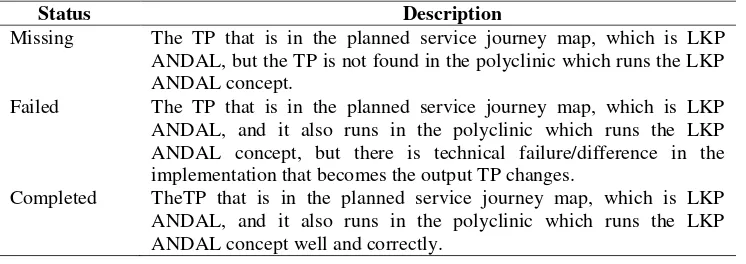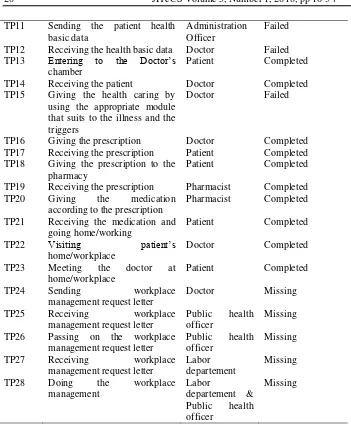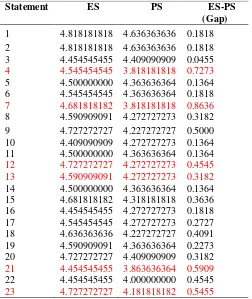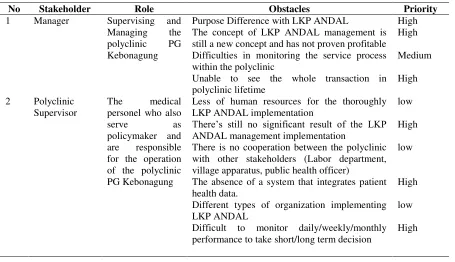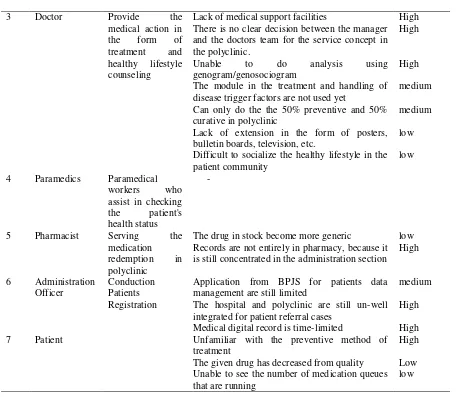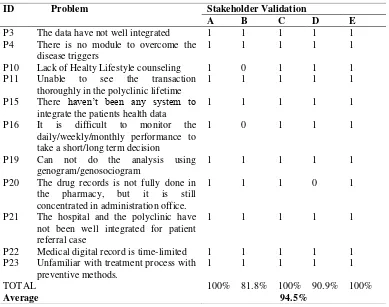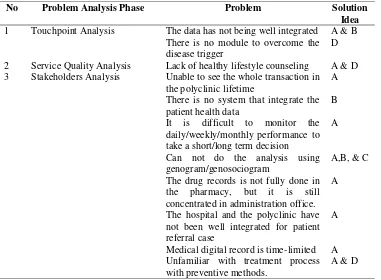Journal Homepage: www.jitecs.ub.ac.id
Service Design of Implementation Primary Health Care
Management Model Service “Andal” in PG Kebonagung
Polyclinic, Malang District
Yasir Sani1, Ismiarta Aknuranda3, Herman Tolle2
Faculty of Computer Science, Brawijaya University, 65145 - Malang, East Java, Indonesia
[email protected], [email protected],[email protected]
Received 17 April 2018; accepted 08 June 2018
Abstract. The concept of Primary Health Service Management Model “Andal”
(LKP Andal) in Indonesia was initiated by the Public Health Association of Brawijaya University (IKEMAS UB) to solve the health service management problem in Indonesia. LKP Andal was piloted into a first-level organization that provide the health service/facility in PG Kebonagung polyclinic in Malang district.This research uses a service design approach to explore the problems and this study also provide a service solution to the LKP Andal implementation in IT perspective that suits to the organization characteristics as an entirely service delivery process support. As the result, this study has explored 23 main problems of the entirely service delivery process and also resulted 4 service solution ideas which were visualized using Service Journey Modelling Language (SJML) to acquire more detailed images and they can become the standard communication among stakeholders.
1.
Introduction
The family-doctor-based primary health service management model (Layanan Kesehatan Primer – LKP) is a proposed model of Public Health Association of Medical Faculty, Brawijaya University (IKEMAS UB) on the health management issues raised in Indonesia [1]. LKP is the first individual contact as well as community group contact as the beginning of health service [2]. This model is an update management model of the pre-existing primary health service management by applying the family medical clinic. Family medical clinic is a practice where there are basic preventive and basic treatment efforts. Later, this model is called as LKP’s
organization and management model that is “reliably (andal)”. Andal is meant that the
characteristic of the proposed management model are strategic, integrative, effective, efficient, quality, equally, and affordable [1]. One of the issue can be solved by proposed LKP ANDAL management model is the high allocation of state-budget (APBN) expenditure for the health sector is not proportional to the health effect of improvement in Indonesia.
clinic of PG. Kebonagung, Pakisaji, Malang district. On the implementation process, there are some issues in the adjustment between the main purpose of LKP Andal and the characteristics of the polyclinic (such as human resources, organizational skill, patient habit, ect.).
Patients’ constraints and perceptions to the service quality of the LKP Andal
management implementation should be well defined correctly. The purpose is that the polyclinic can see the internal problem of the PG Kebonagung Polyclinic organization. By settling down the LKP Andal management implementation problem, PG Kebonagung polyclinic can perform the LKP Andal management that suits to the polyclinic characteristics without reducing the objectives achievement of LKP Andal mangement. Moreover, the obtained cognition in this research can be applied in other first-level-health-facility or polyclinic that will apply the LKP Andal management. The approach that can be used to reveal the constraints of the LKP Andal managemet implementation and make a service solution idea to overcome the problem, the researcher proposes the service design approach.
This research use the approach of service design to explore the problem deeper and provide the service design approach from the point-of-view of the IT implementation in service. The service design approach is an approach that used to illustrate the a complex [3] and the whole experience and interaction in the service delivery process [4] by making the stakeholders as the center of service design [3] [5]. The developing of service design in health sector has been done by Lell [6] and Dahlgren & Lycke [7] in the previous studies. The research made the service design from the arisen problem from the unavailability of service systematic that suits to the service user requirement. Both studies revealed that there were some advantages in designing service by involving the users especially in eliciting the intangible service elements, such as the interaction and understanding of the actors involved in the service process.
2.
Methodology
This research applies the service design process to collect information by using the semi-structured and questionnaire interview deeply technique. The interview is done
to all stakeholders, while the servqual is given to elicitate the patient’s satisfaction.
2.1The Problem Analysis
In this stage, the analyzing of data collected is done which is used for building the idea/thought/insight. The idea then becomes the the base in the service design visualisation process. The researcher makes 3 analysis in this phase, which are:
Touchpoint Analysis, Patients’ Satisfaction Analysis and Stakholder Analysis.
2.1.1 Touchpoint Analysis
Touchpoint analysis is done by visualizing the service delivery process of LKP Andal
(planning) of the Nugraha’s research [8] into a journy map service form by using
2.1.2 Patients’ Satisfaction Analysis
Besides the touchpoint analysis, the researcher also analyze the result of the patient perception collecting to determine the patients’ satisfaction level. The process is done to find out whether the questions in the questionnaire that leads to the LKP Andal
management characterstics which influences the patients’ satisfaction to the whole
process of service delivery.
2.1.3 Stakeholder Analysis
For the data enrichment as the basic materials of service system implementation consideration, the researcher also does the analysis to the stakeholder involved in health service in polyclinic PG Kebonagung. The stakeholder are the company manager, polyclinic supervisor, doctor, midwife, administration officer, and pharmacy clerk. The analysis starts by doing the data collecting phase which are the problems faced by stakeholders in LKP Andal implementation at polyclinic PG Kebonagung in accordance with the stakeholders role.
2.2 Insight Definition
In this stage, the researcher defined the insight obtained based of the data analysis result from the analysis phase. the researcher defines the problems and filters the problems that can be solved by implementing the IT system. This is because in this study, the researcher only focuses on the IT implementation based solutions.
2.3 Service Solution Idea Development
The next service design approach stage is the service solution idea development stage. this development is done by considering insight that obtained from the previous phase. The final output of the idea development stage is in the form of service idea and also scenario when it is implemented in the service process at polyclinic PG Kebonagung.
2.4 Prototype Development (Service Design Visualization)
The prototype development is the stage that is done in the end of the service design process. There are some prototype development methods, one of them is by doing service design visualization to obtain the user’s feedback [3]. In this prototype development stage, the researcher develops the service journey map visualization by using the modelling language Service Journey Modelling Language (SJML) [10]. This modelling languange is chosen because it allows more actors involve in on overall service design illustration along with the actors interactions one to another in the service delivery process [10]. Furthermore, SJML also descripts the whole activities of the actors whether they are TP or single activity that does not interact to other actor (action) which use swimlane view.
3.
“Andal”
Primary Health Service Design
3.1Problem Analysis
3.1.1 Touchpoint (TP) Analysis
Touchpoint is analyzed based on the status in the implementation, which are Missing, Failed and Completed. The TP analysis description is shown in Table 1. After the service delivery process has been analyzed by using SJML in the LKP Andal management to the implemetation in polyclinic PG Kebonagung, and the status has been determined, there are 11 Missing Touchpoints, 3 TP Failed Touchpoints, and 14 TP Completed Touchpoints found.
Table 1. The TP Status on Service Journey Map
The conclussion of the touchpoint analysis can be seen in Table 2. There are 14 Completed TPs, 3 Failed TPs, and 14 Missing TPs.
Table 2. Touchpoint Analysis Results
TP Code
Touchpoint Actor Status
TP1 Giving the Health Basic Data Form
Health worker Missing
TP2 Receiving the Health Basic Data Form
Patient Missing
TP3 Giving the Health Basic Data Form
Patient Missing
TP4 Receiving the Health Basic Data Form
Health worker Missing
TP5 Giving the local community health basic data
Health worker Missing
TP6 Saving/keeping the health basic data
Administration Officer
Missing
TP7 Coming to polyclinic Patient Completed
TP8 Giving the health insurance (BPJS) identity
Patient Completed
TP9 Receiving Patients Administration
Officer
Completed
TP10 Checking the Patients BPJS status data
Administration Officer
Completed
Status Description
Missing The TP that is in the planned service journey map, which is LKP ANDAL, but the TP is not found in the polyclinic which runs the LKP ANDAL concept.
Failed The TP that is in the planned service journey map, which is LKP ANDAL, and it also runs in the polyclinic which runs the LKP ANDAL concept, but there is technical failure/difference in the implementation that becomes the output TP changes.
TP11 Sending the patient health basic data
Administration Officer
Failed
TP12 Receiving the health basic data Doctor Failed TP13 Entering to the Doctor’s
chamber
Patient Completed
TP14 Receiving the patient Doctor Completed
TP15 Giving the health caring by using the appropriate module that suits to the illness and the triggers
Doctor Failed
TP16 Giving the prescription Doctor Completed
TP17 Receiving the prescription Patient Completed TP18 Giving the prescription to the
pharmacy
Patient Completed
TP19 Receiving the prescription Pharmacist Completed TP20 Giving the medication
according to the prescription
Pharmacist Completed
TP21 Receiving the medication and going home/working
Patient Completed
TP22 Visiting patient’s
home/workplace
Doctor Completed
TP23 Meeting the doctor at home/workplace
Patient Completed
TP24 Sending workplace
management request letter
Doctor Missing
TP25 Receiving workplace
management request letter
TP27 Receiving workplace
management request letter
From the entire touchpoint analysis result, there are some basic problems obtained regarding the LKP Andal that implemented in polyclinic PG Kebonagung.the problems is shown in Table 3.
Table 3. The Problems Summary of Touchpoint Analysis
ID Problem
P1 Lack of human resources
P2 The relationship with external (village apparatus) P3 The data is not well integrated yet
P4 There haven’t been a module to overcome the
3.1.2 Service Quality Analysis
This analysis is done by using servqual technique, where the patient is asked for their response through the statement given based on the tangible, reliability, responsiveness, assurance and emphaty aspects.
Table 4. The Patients’s Satisfaction Average Result to the Service in polyclinic
In Table 4, we can see the analysis result of patients satisfaction as the service user. In this analysis, there were 22 patients involved as the respondents with 23
statements givent to the patients. The patients’ respons analysis result to the
statements is shown in Table 5.
In Table 5, we can see the statement number 7, “The availability of medication is
completed” has a very high gap between the expectation and the reality received by
the patients. It is not only because of the polyclinic self-decision, but there is also other responsible party, such as BPJS, so a joint solution is required.
From the whole service quality result, some basic problems occure regarding the
LKP Andal implementation in polyclinic PG Kebonagung, from the patient’s point of
view, as the service recipients. The problems is shown in Table 6.
There are some effects of the external factor from the gaps found in retrieving data from patients that may cause the patient's answer to be biased. For example, the condition of the ill patient, the service condition of the polyclinic at that time may not be good, the patient's ability to determine the questionnaire level. Therefore, the servqual uses only one of the three techniques in this study.
Respondent ES PS ES-PS Satisfaction
1 4.7 4.17 0.52173913 Less satisfied
2 4.7 4.043 0.739130435 Less satisfied
3 5 4.09 0.9130435 Less satisfied
4 4.13 4 0.0869565 Satisfied
5 4 3.8 0.17391 Less satisfied
6 4.7 4.74 -0.043478 More satisfied
7 5 4.87 0.1304348 Less satisfied
8 4.57 4 0.5652174 Less satisfied
9 4.3 4.3 0.08696 Satisfied
10 4.9 4.4 0.47826 Less satisfied
11 5 4.1 0.86956 Less satisfied
12 4.57 4.43 0.130434 Less satisfied
13 4.65 4 0.6086957 Less satisfied
14 4.4 4.65 -0.217391 More satisfied
15 4.96 4 0.956522 Less satisfied
16 4.57 4.8 -0.26087 Less satisfied
17 4.4 3.9 0.478261 Less satisfied
18 4.09 4.35 -0.26087 More satisfied
19 4.6 4.35 0.2608696 Less satisfied
20 4.6 3.96 0.652174 Less satisfied
21 4.6 3.96 0.652174 Less satisfied
22 4.52 4.7 -0.173913 More satisfied
Table 5. The Gap results to the SERVQUAL questionnaires
Table 6. Service Quality Analysis Problems Summary
3.1.3 Stakeholder Analysis
The stakeholder analysis is done by defining the role of every stakeholder and finding out the obstacles faced during the LKP Andal implementation process. The stakeholder specification involved in the interview session can be seen in Table 7. Afterward the problems prioritizing is done to recognize the problem which can be solved by the organization. The result is shown in Table 8.
In table 7 there are 7 stakeholders interviewed to collect the data in form of problems with the LKP ANDAL implementation. From those problems there are 13
Statement ES PS ES-PS
(Gap)
1 4.818181818 4.636363636 0.1818 2 4.818181818 4.636363636 0.1818 3 4.454545455 4.409090909 0.0455
4 4.545454545 3.818181818 0.7273
5 4.500000000 4.363636364 0.1364 6 4.545454545 4.363636364 0.1818
7 4.681818182 3.818181818 0.8636
8 4.590909091 4.272727273 0.3182 9 4.727272727 4.227272727 0.5000 10 4.409090909 4.272727273 0.1364 11 4.500000000 4.363636364 0.1364
12 4.727272727 4.272727273 0.4545
13 4.590909091 4.272727273 0.3182
14 4.500000000 4.363636364 0.1364 15 4.681818182 4.318181818 0.3636 16 4.454545455 4.272727273 0.1818 17 4.545454545 4.272727273 0.2727 18 4.636363636 4.227272727 0.4091 19 4.590909091 4.363636364 0.2273 20 4.727272727 4.409090909 0.3182
21 4.454545455 3.863636364 0.5909
22 4.454545455 4.000000000 0.4545
23 4.727272727 4.181818182 0.5455
ID Problem
P5 Incomplete equipment
P6 Medical supplies that are considered incomplete P7 A long time for the whole service process P8 Less Medical Worker for Hearing the patients P9 Lacking in greetings
problems obtained with highest priority to be solved by the polyclinic with the existing resources. The problems identification is also become the important consideration in making service solution idea.
From the stakeholders analysis result and the priority setting to the problems, there are some problems obtained with the high level solving requirement priority. Table 8 shows the high priority problems and Table 9 shows problem summary from stakeholder analysis.
Table 7. Stakehoder Specification involved in the research
Code Stakeholder Age (year) Gender Education
Background
Table 8. Stakholder analysis result and problem prioritizing
No Stakeholder Role Obstacles Priority
1 Manager Supervising and
Managing the polyclinic PG Kebonagung
Purpose Difference with LKP ANDAL High The concept of LKP ANDAL management is still a new concept and has not proven profitable
High
Difficulties in monitoring the service process within the polyclinic with other stakeholders (Labor department, village apparatus, public health officer)
low
The absence of a system that integrates patient health data.
High
Different types of organization implementing LKP ANDAL
low
Difficult to monitor daily/weekly/monthly performance to take short/long term decision
3 Doctor Provide the
Lack of medical support facilities High There is no clear decision between the manager and the doctors team for the service concept in disease trigger factors are not used yet
medium
Can only do the the 50% preventive and 50% curative in polyclinic
medium
Lack of extension in the form of posters, bulletin boards, television, etc.
low
Difficult to socialize the healthy lifestyle in the patient community
low
4 Paramedics Paramedical workers who
The drug in stock become more generic low Records are not entirely in pharmacy, because it is still concentrated in the administration section
High management are still limited
medium
The hospital and polyclinic are still un-well integrated for patient referral cases
High
Medical digital record is time-limited High
7 Patient Unfamiliar with the preventive method of
treatment
High
The given drug has decreased from quality Low Unable to see the number of medication queues that are running
low
Table 9. Problems Summary from Stakeholder Analysis
ID Problem
P11 Unable to see all transactions that exist in the polyclinic lifetime.
P12 The concept of LKP ANDAL Management is still a new concept and has not proven profitable.
P13 Goal Difference with LKP ANDAL
P14 Not seen significant results from the implementation of LKP Andal management
P15 The absence of a system that integrates patient health data.
P16 Difficult to monitor daily/weekly/monthly performance to take short/Long term decision.
P17 Lack of medical support facilities
3.2 Defining Insight
Based on the problem analysis in the previous stage, then in this stage of the insight defining, the researcher filters any problems that can be solved from the view of solution using the IT implementation. Table 10 shows the insight in the form of obtained problems.
In this study, besides filtering the problems that are going to be solve, the researcher also defining the correctnes of filtered problems. The result in Table 10 also shows that 94.5% of defined problems are validated correctly by the stakeholders. As for the stakeholders involved are five people, that is enough to get the result of > 80% of the overall validation results [14].
Table 10. The Definition and Validation of Problems to be Resolved
ID Problem
P19 Unable to do analysis using genogram/genosociogram
P20 Records are not entirely in pharmacy, because it is still concentrated in the administration section
P21 The hospital and polyclinic are still un-well integrated for patient referral cases
P22 Medical digital record is time-limited
P23 Unfamiliar with treatment process with preventive methods.
ID Problem Stakeholder Validation
A B C D E
P3 The data have not well integrated 1 1 1 1 1
P4 There is no module to overcome the disease triggers
1 1 1 1 1
P10 Lack of Healty Lifestyle counseling 1 0 1 1 1
P11 Unable to see the transaction thoroughly in the polyclinic lifetime
1 1 1 1 1
P15 There haven’t been any system to integrate the patients health data
1 1 1 1 1
P16 It is difficult to monitor the daily/weekly/monthly performance to take a short/long term decision
1 0 1 1 1
P19 Can not do the analysis using genogram/genosociogram
1 1 1 1 1
P20 The drug records is not fully done in the pharmacy, but it is still concentrated in administration office.
1 1 1 0 1
P21 The hospital and the polyclinic have not been well integrated for patient referral case
1 1 1 1 1
P22 Medical digital record is time-limited 1 1 1 1 1 P23 Unfamiliar with treatment process with
preventive methods.
1 1 1 1 1
TOTAL 100% 81.8% 100% 90.9% 100%
3.3Service Design Solution Idea Development
After obtaining the problems to be resolved in the research, the next phase is to develop the service solution idea. In this stage, the researcher has been succeeded generating 4 service design ideas, which are:
A. Establish an IT system in a service process that is capable of integrating all elements in polyclinic.
B. Develop an integrated data storage and management system.
C. Build a system or use a third party service to create a genogram from the existing patient data.
D. Moving the service process in the form of disease triggers counseling and healty lifestyle in to digital form (SMS).
All service solution design produced by obtained problems and relates to the information technology implementation to support the service delivery process and
also the stakeholders’ requirement of the system. The conformity between the
problems and the service solution ideas are shown in Table 11.
Table 11. The Problems and Solution Conformity
3.4 Prototype Development (Service Design Visualization)
In this stage, the result obtained from the solution formulation is being prototyped into service design solution idea visualization that has been made in the previous stages. The visualization is in the form of service journey map (see Fig. 1). The service
No Problem Analysis Phase Problem Solution
Idea
1 Touchpoint Analysis The data has not being well integrated A & B There is no module to overcome the
disease trigger
D
2 Service Quality Analysis Lack of healthy lifestyle counseling A & D 3 Stakeholders Analysis Unable to see the whole transaction in
the polyclinic lifetime
A
There is no system that integrate the patient health data
B
It is difficult to monitor the daily/weekly/monthly performance to take a short/long term decision
A
Can not do the analysis using genogram/genosociogram
A,B, & C
The drug records is not fully done in the pharmacy, but it is still concentrated in administration office.
A
The hospital and the polyclinic have not been well integrated for patient referral case
A
Medical digital record is time-limited A Unfamiliar with treatment process with preventive methods.
journey map is using the service modelling language (SJML) [10]. The main purpose of making the prototype in the form of service design visualization is to make a standard language of service solution that will become the communication tool for the stakeholders to understand the service delivery process thorougly.
Pasien
Fig. 1 Service Journey map Visualization using SJML
Before the visualization, the researcher makes the scenario of service delivery process that apply the service design solution idea that produced descriptively, then it is made as the reference material in making the service design visualization. The service design visualization result can be seen in Appendix A.
The service design solution idea scenarios are:
1. The patient comes to polyclinic and make registration by showing their identity card or BPJS card and family card.
2. The administration officer registers the patient’s registration by inputing the
patient only has to show their BPJS card (old patient’s family health basic data
has already been registrated).
3. The administration officer prints the patient queue number and gives it to the patient
4. At the same time, the health worker receives the information regarding the
patient arrival and receive the patient’s family healty basic data.
5. Patient comes to the health checking table to get the current health status (blood pressure, body temperature, body height, body weight, respiratory rate, etc). 6. The paramedics do to patient’s health status checking.
7. The paramedics send the patient’s family health basic data and patient’s status data to the general practitioner.
8. Patient comes into the doctor’s room and receives the medical treatment and counseling.
9. Doctor gives the diagnosis, medication and counseling to the patient according
to the patient’s status data and family health data in the form of genogram (The
genogram is automatically made according to the patient’s family basic data input).
10. Doctor gives the prescription to the pharmacist.
11. Doctor gives the module of patient’s disease trigger to the patient. After that, the doctor gives the explanation about the disease prevention and also gives the healthy lifestyle almanac made by polyclinic.
12. Doctor gives the notification to the administration officer that the patient has finished the examination and the doctor sends the checkup data and also the disease trigger module.
13. Administration officer sends the message to the patient via mobile device (SMS)
which informs the patient’s disease trigger and the healthy lifestyle.
14. The pharmacist receives the prescription and provides the drugs according to the prescription.
15. The pharmacist inputs the patient’s prescription data into the system. Then the system automatically will differentiates the BPJS drug to the non-BPJS drug. 16. The medicine that is paid by BPJS will be reported to BPJS automatically. 17. The paramedics send the drug stock status data to the manager.
18. Doctor appraises the patient’s illness status and the properness to make home visiting.
19. Doctor sends the request to the polyclinic supervisor in order make home/workplace health visit
20. The polyclinic supervisor receives the request and send the assignment letter for paramedics to make the home/workplace health visit.
21. Paramedics make the patient’s home/workplace visit and do the medical action
regarding the patient’s illness and also do the counseling for the patient and the patient’s family/co-workers. The given counseling is about the contagion prevention of the same disease and also the healthy lifestyle almanac, based on
the family doctor’s module.
22. Paramedics send the report of the medical treatment and counseling result to the doctor via Electrical Health Record (EHR). And the report is also sent to the polyclinic manager and supervisor.
process of service delivery. Other than activity, the time-spent rationality in one service is also being evaluated. In this evaluation, the stakeholders are asked to give the judgement regarding the service design solution idea validity, which is divided into 3 parts; stakeholder validity, activity validity and actor interaction validity with
total of 29 valuation items. Stakeholders are asked to rate “TRUE” (if the activity is
absolutely true), “LESS TRUE” (if one of variable in the activity is not accordance
such as the relation, channel, TP description, etc), and “FALSE” (if the activity is
done wrong, for instance wrong executor of activity, no intended activity, etc). Channel is the media used in the interaction of the touch point. Table 12 shows the result of correctness evaluation to 5 stakeholders.
Table 12. Correctness Evaluation Result
Participant TRUE LESS
TRUE
FALSE Correctness
(%)
I 26 2 0 89.6
II 23 4 1 79.3
III 26 1 1 89.6
IV 25 3 0 86.2
V 26 2 0 93.1
Average 87.5
The result ini Table 12 shows that generally the average of validity percentage of the service design solution is majorly validated, which is 87.5%, and there are some minor fault that has to be considered to earn maximum service design. After doing the deeper analysis about the entirely correctness evaluation result (for the “LESS TRUE”
and “FALSE” poins) from the stakeholders, the feedback are obtained. The feedbacks
are in form of arisen problem at the service solution idea that can be the consideration in service design refinement; which are:
1. The short message service delivery in the form of illness triggers and digital counseling can be moved to the paramedics or doctor. It is because the
administration officer does not very understand the patient’s condition.
2. For the manager role, the interaction can be expanded, becouse the manager should know the progress of the polyclinic condition daily.
3. Time estimation must be more realistic and detailed per activity.
4. Tablet channel used on doctor’s activity can be 1 type, for example: all use the tablet without anymore computer interaction.
For service design enhancement based on correctness evaluation result can be seen in Appendix A.
4.
Conclusion
The outcome were 4 service solution ideas: (1) Establish an IT system in the service process that capable for integrating all elements in polyclinic, (2) Developing an integrated data storage and management system, (3) Build a system or use a third party service to create a genogram from the existing patient data, (4) Moving the service process in the form of disease triggers counseling and healty lifestyle in to digital form (SMS).
The service solution ideas then is made into a prototype in form of service design visualization to illustrate the service journey map when it is implemented in form of modelling language SJML and than being evaluated. The result of evaluation shows that the modelling language is 87,5% TRUE (logic, suits to the requirement and applicable)
References
[1] Roebijoso, J., & Andarini, S. Pengembangan Model Organisasi dan Manajemen Pelayanan Kesehatan Primer yang Handal : Strategik, Integratif, Efektif, Efisien, Kualitas, Merata, dan Terjangkau. 2016.
[2] Departemen Kesehatan Republik Indonesia,. Sistem Kesehatan Nasional. [pdf] Departemen Kesehatan Republik Indonesia. Tersedia di: http://pppl.depkes.go.id/_asset/_regulasi/KEPMENKES_374-2009_TTG_SKN-2009.pdf [Diakses 25 April 2017]
[3] Polaine, A., Løvlie, L., and Reason, B.Service Design: From Insight to Implementation. United States of America: Rosenfeld Media, LLC,2013.
[4] Moritz, S.,. Desain layanan : Practical Access to An Evolving Field. MEDes – MA European Studies in Design, 2005.
[5] Segelstrom, F, Stakeholder Engagement for Desain layanan : How services designtrs identify and communicate insights. Departemen Of Computer and Information Science, Linkoping University, 2013.
[6] Lell, T., Implementation Of Desain layanan Methodologies In Improvement Of Medication Management Process From Patients ’ Perspective. Health Care Technology, 2015.
[7] Dahlgren, L. & Lycke, K., Desain layanan in user-centered healthcare – The case of child obesity. School of Business, Economics and Law University of Gothenburg, 2015. [8] Cahya, D. et al., A Business Architecture Modeling Methodology to Support the
Integration of Primary Health Care : Implementation of Primary Health Care in Indonesia. internetworking Indonesian Journal, 9(1), pp.39–45, 2017.
[9] Halvorsrud, R. et al., Components of a Visual Language for Service Design. ServDes - Fourth Service Design and Innovation conference, pp.291–300, 2014.
[10] Lee, E., Karahasanović, A. & Halvorsrud, R., A Visual Language for the Modelling of Service Delivery Processes to Support Business Processes Management. International Journal on Advance in Software, 8(3), pp.288–308, 2015.
[11] Schalles,C., Usability Evaluation of Modelling Languages. Springer Gabler. ISBN 978-3-658-00050-9. Leidersbach, Germany, 2012.
[12] Nielsen, J., Prioritizing Web usability. New Riders, 2006.
[13] Stickdorn, M. & Schneider J., This is service design Thinking. Basic – Tools – Cases. Amsterdam: BIS Publishers, 2010.
APPENDIX A.
Service Jouerney Map
Pasien
Petugas admin
Paramedis
Dokter
Petugas Farmasi
Sistem EHR
BPJS
Pengelola
Penanggung Jawab
Data dasar kesehatan keluarga telah tersimpan
dan Kedatangan Pasien telah terdaftar
Datang ke poliklinik
Menerima Pasien
Memberikan nomer antrian pemeriksaan Menerima nomer antrian pemeriksaan
Mengirim pemberitahuan antrian pasien
Menerima data antrian pasien
Data antrian telah diperbarui
Menerima data dasar kesehatan keluarga Memberikan
BPJS & KK / data dasar kesehatan keluarga
Melakukan registrasi data kesehatan dasar keluarga dan pendaftaran
Mencetak nomer antrian pemeriksaan
Membaca data jumlah peserta harian
Pasien
Petugas admin
Paramedis
Dokter
Petugas Farmasi
Sistem EHR
BPJS
Pengelola
Penanggung Jawab
Menerima Pasien Datang ke meja pemeriksaan status kesehatan
Mengirim data Hasil anamnesis pasien ke dokter
Menerima data pasien
Data status kesehatan pasien telah teregistrasi
Menerima Pasien
Masuk keruang dokter
Melakukan pemeriksaan anamnesis Menerima pemeriksaan dari paramedis
Memberikan KIE dan tindakan kesehatan Menerima KIE dan tindakan kesehatan
Memberikan diagnosis
Diagnosis pasien teregistrasi
Membaca diagnosis pasien
Pasien
Petugas admin
Paramedis
Dokter
Petugas Farmasi
Sistem EHR
BPJS
Pengelola
Penanggung Jawab
Data penggunaan obat oleh pasien terupdate Resep teregistrasi
Memberikan obat sesuai resep
Menerima obat
Menginput data obat yang digunakan pasien ke data rekam medis pasien
Mengirimkan pemberitahuan pasien telah selesai diperiksa kepada petugas admin Menerima pemberitahuan penanganan pasien dari dokter
Mengirimkan pesan faktor pemicu pasien dan primbon pola hidup sehat (KIE digital)
Menerima pesan faktor pemicu pasien dan primbon pola hidup sehat (KIE digital)
mengirimkan resep ke apoteker Memeriksa
stok obat diapotik
Menerima resep obat
Pasien
